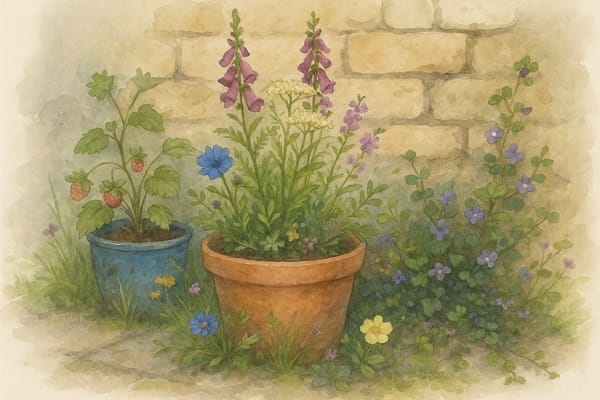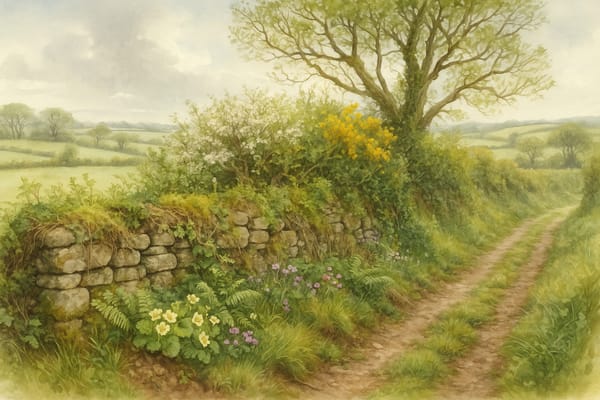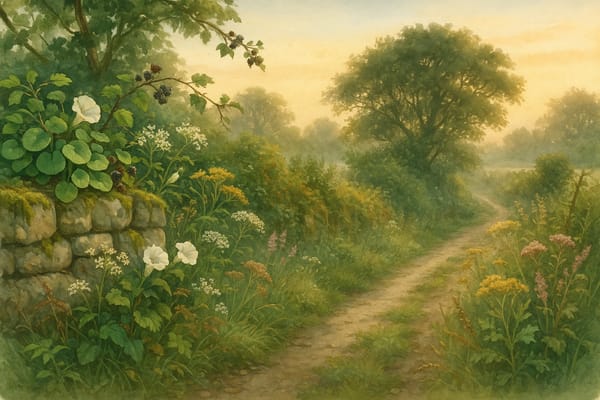There’s something unmistakably Cornish about a garden that feels a little untamed. A pot brimming with foxgloves, a stray wild pansy in a cracked wall, or the hum of a bee hovering over yarrow on a windswept patio—these simple moments root us in nature’s quiet beauty.
At The Cornish Garden, we believe wild gardening isn’t about grand landscapes. It’s about letting nature weave its way into the spaces we tend—however small. Whether you garden a courtyard, balcony, or a scattering of pots outside your door, you can bring Cornwall’s wild charm into your life, one container at a time.
Why Wild Gardening Works—Especially in Small Spaces
- It Connects You to Cornwall’s Landscape:
Even a single pot of native wildflowers echoes the meadows, hedgerows, and coastlines of Cornwall’s natural world. - It Supports Local Wildlife:
Native and self-seeding plants offer essential food and shelter for bees, butterflies, and birds—creatures that weave Cornwall’s ecosystem together. - It Creates Effortless Beauty:
These plants grow with the seasons, changing naturally, and needing little fuss or constant replanting. - It Brings Peace to Busy Lives:
Tending a pot of self-seeded aquilegia or watching a blackbird visit your balcony creates a space for pause—and a sense of belonging to the wild world beyond.
Cornish-Inspired Planting Ideas for Pots and Balconies
The Pollinator Pot
Mix yarrow, cornflower, monarda, and wild strawberry in a deep terracotta pot. Let wild pansies trail at the edges. The result? A living snapshot of Cornish hedgerows—and a magnet for bees and butterflies.
The Vertical Wildflower Wall
Stack containers or hang a vertical planter with foxglove, aquilegia, and heuchera. Add trailing ivy-leaved toadflax and forget-me-nots at the base for that soft, natural edge that Cornish gardens do so well.
The Mini-Pond in a Tub
An upcycled basin planted with water forget-me-not, marsh marigold, and soft rush brings life—and visiting wildlife—even to a balcony or small patio. A nod to Cornwall’s streams and rain-fed ditches.
The Soft-Grass Corner
Fill a pot with Stipa tenuissima, soft fescues, and wild pansies. The gentle movement catches the light and recalls windswept Cornish coastal grasses.
The Herbal Wildlife Balcony
Chives, mint, thyme, and oregano—fragrant, useful, and perfect for pollinators. Let them flower freely, and you’ll have a buzzing, aromatic retreat.
How to Let the Wild In—Cornish Garden Style
- Choose Native & Naturalised Plants:
Look for Cornish favourites—foxglove, wild strawberry, yarrow, aquilegia, forget-me-not. - Let Self-Seeders Surprise You:
Embrace the gentle chaos. A poppy sprouting in a pot or a pansy in a paving crack is part of the charm. - Skip the Chemicals:
Go peat-free, pesticide-free, and pollinator-friendly. Cornwall’s wildlife will thank you. - Use Simple, Rustic Materials:
Terracotta pots, weathered wood, stone planters—natural textures that echo Cornwall’s landscape. - Create Wildlife Moments:
A shallow dish of water. A small bundle of twigs for overwintering insects. Leave some seed heads for birds.
The Cornish Garden’s Wild Container Favourites
| Setting | Plants for Sun | Plants for Shade |
|---|
| Windowbox | Cornflower, poppy, wild pansy | Welsh poppy, ferns, violets |
| Hanging Pot | Trailing wild strawberry, mint | Ivy-leaved toadflax, campanula |
| Large Tub | Asters, foxglove, heuchera | Ferns, aquilegia, wood sorrel |
| Mini-Pond | Water mint, marsh cinquefoil | Soft rush, water forget-me-not |
A Wild Invitation to Pause
In Cornwall, wildness is never far away. It dances in the hedgerows, lingers on the breeze, and finds its way into gardens—small or grand. Whether you tend a tucked-away balcony or a scatter of pots by the door, wild gardening is your invitation to slow down, let nature in, and become part of a living story that stretches from coast to cottage to your own quiet corner.
Let your small space bloom wild—and bring a little piece of Cornwall home.











